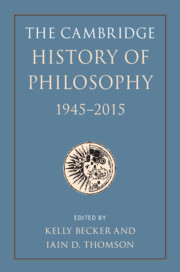Book contents
- The Cambridge History of Philosophy, 1945–2015
- The Cambridge History of Philosophy, 1945–2015
- Copyright page
- Contents
- Contributors
- Preface and Acknowledgments
- Introduction
- Part I Analytic Philosophy
- Section One Language, Mind, Epistemology
- Section Two Logic, Metaphysics, Science
- 10 Logic in the Second Half of the Twentieth Century
- 11 (Re)discovering Ground
- 12 Lewis’s Theories of Causation and Their Influence
- 13 Naturalism from the Mid-Twentieth Century to the Present
- 14 The History of Philosophy of Science
- 15 A Modern Synthesis of Philosophy and Biology
- Section Three Analytic Moral, Social, and Political Philosophy
- Section Four Analytic Aesthetics and Philosophy of Religion
- Part II Continental Philosophy
- Part III Bridge Builders, Border Crossers, Synthesizers, and Comparative Philosophy
- Part IV Epilogue: On the Philosophy of the History of Philosophy
- References
- Index
10 - Logic in the Second Half of the Twentieth Century
from Section Two - Logic, Metaphysics, Science
Published online by Cambridge University Press: 08 November 2019
- The Cambridge History of Philosophy, 1945–2015
- The Cambridge History of Philosophy, 1945–2015
- Copyright page
- Contents
- Contributors
- Preface and Acknowledgments
- Introduction
- Part I Analytic Philosophy
- Section One Language, Mind, Epistemology
- Section Two Logic, Metaphysics, Science
- 10 Logic in the Second Half of the Twentieth Century
- 11 (Re)discovering Ground
- 12 Lewis’s Theories of Causation and Their Influence
- 13 Naturalism from the Mid-Twentieth Century to the Present
- 14 The History of Philosophy of Science
- 15 A Modern Synthesis of Philosophy and Biology
- Section Three Analytic Moral, Social, and Political Philosophy
- Section Four Analytic Aesthetics and Philosophy of Religion
- Part II Continental Philosophy
- Part III Bridge Builders, Border Crossers, Synthesizers, and Comparative Philosophy
- Part IV Epilogue: On the Philosophy of the History of Philosophy
- References
- Index
Summary
Modern logic emerged in the period from 1879 to the Second World War. In the post-war period what we know as classical first-order logic largely replaced traditional syllogistic logic in introductory textbooks, but the main development has been simply enormous growth: The publications of the Association for Symbolic Logic, the main professional organization for logicians, became ever thicker. While 1950 saw volume 15 of the Journal of Symbolic Logic, about 300 pages of articles and reviews and a six‑page member list, 2000 saw volume 65 of that journal, over 1,900 pages of articles, plus volume 6 of the Bulletin of Symbolic Logic, 570 pages of reviews and a sixty‑page member list. Of so large a field, the present survey will have to be ruthlessly selective, with no coverage of the history of informal or inductive logic, or of philosophy or historiography of logic, and slight coverage of applications. Remaining are five branches of pure, formal, deductive logic, four being the branches of mathematical logic recognized in Barwise 1977, first of many handbooks put out by academic publishers: set theory, model theory, recursion theory, proof theory. The fifth is philosophical logic, in one sense of that label, otherwise called non-classical logic, including extensions of and alternatives to textbook logic. For each branch, a brief review of pre‑war background will be followed by a few highlights of subsequent history. The references will be a mix of primary and secondary sources, landmark papers and survey articles.
- Type
- Chapter
- Information
- The Cambridge History of Philosophy, 1945–2015 , pp. 137 - 146Publisher: Cambridge University PressPrint publication year: 2019



